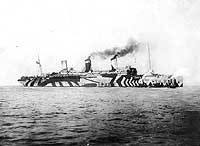
U.S. NAVY TEMPORARY AUXILIARY SHIPS, 1917-1919
WORLD WAR I ERA TRANSPORTS --
with Three Smokestacks
Only two WWI era U.S. Navy transports had three smokestacks. Both were originally German passenger liners completed in 1913-1914 as the then-largest ships in the World. One was seized by the U.S. Government in 1917. The other, which spent the war in Germany, was taken over early in 1919 to bring American service personnel home from Europe.
Though differing in detail, these ships were similar appearance, with bulky hulls and superstructures and large stacks spaced evenly amidships. While in Naval service, Leviathan was painted overall grey (1917 to early 1918, and 1919) or in pattern camouflage (most of 1918), while Imperator retained her civilian paint scheme (black hull and white superstructure).
This page features a table (with links to individual ships) of World War I era U.S. Navy transports with three smokestacks, plus one photograph of each ship in this group.
Click the small photographs to prompt a larger view of the same image with a descriptive header.
Ships in this group:
TWO SHIPS -- THREE SMOKESTACKS and TWO MASTS:

